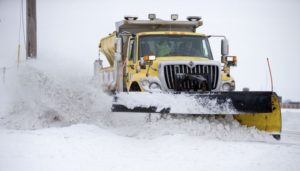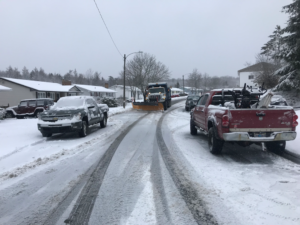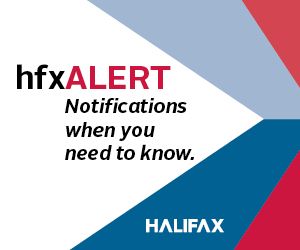 Winter has arrived.
Winter has arrived.
As I’m writing this post I’m looking out over a day where it’s below freezing. I’m thinking back to the two storms that we’ve already had this year and the many that we had last year. I’ve also been thinking about the semi-annual newsletter that I have sent out to every household in Lower Sackville. That newsletter can’t go out this year because of COVID budget cuts. Some of the information here would have appeared in that newsletter, for example the tables of winter service standards.
Over the years I’ve had many conversations with friends and neighbours in Lower Sackville, HRM staff, contractors, and fellow Councillors. This post contains the most useful information that could help you through the winter, from a municipal perspective. If you would like to see some additional information, or if you notice something that is incorrect, then please let me know and I’ll update the post.
Snow Clearing
Snow clearing is the single busiest part of any storm, and it generally falls in to three phases: before the storm; after the snow starts falling; and after the snow stops falling.
Before the storm
We subscribe to multiple weather services and receive multiple updates daily about weather forecasts. As with any weather system, the information that we receive is not perfect. By subscribing to multiple services we should improve the accuracy of the information.
When we are expecting a storm, and depending on the current conditions, we may have trucks spread rock salt or brine (basically diluted salt water) so that the snow doesn’t stick to the roads. This will help the plows later on.
After the snow starts falling
Many people would like to see us clear the road while the snow is falling. We sometimes do this, but it depends on the amount of snow that has fallen. Our service standards, which are discussed below, show more detail about this. The main roads (P1) will start to be plowed after 2cm or 4cm has fallen, and secondary roads after 10cm has fallen (P2).
After the snow stops falling
For each storm (a “snow event”) we declare a time that the snow stopped falling. This time is significant because it is the basis for all of the snow clearing schedules.
The snow stop time time applies across all of HRM. If snow has stopped falling in your area it may still be falling somewhere else, so we may not have declared this time yet.
Street and Sidewalk Clearing Standards
| Street type | When clearing begins | When clearing should be completed | What clearing should look like |
|---|---|---|---|
| Main arterials (Priority 1) | After 2 cm of snowfall | 12 hours from end of weather event to full driving lanes | Bare pavement driving lanes |
| Halifax Transit routes & collector roads (Priority 1) | After 2 cm of snowfall | 12 hours from end of event to 3 metres centreline bare | 3 metres centreline bare |
| Residential streets with greater than 10% slope that serve as snow routes for Halifax Transit (Priority 1) | After 4 cm of snowfall | 12 hours from end of weather event to centre line bare and 2 lane width | Centreline bare |
| Residential streets (Priority 2) | After 10 cm of snowfall | Cut-throughs completed within first 6 hours and repeated every 8 hours during extended periods of snow | Cut-through |
| Residential streets (Priority 2) | After 10 cm of snowfall | 24 hours from end of weather event to snow-covered, passable state | Snow-covered, passable |
| Gravel roads and private lanes (Priority 2) | After 10 cm of snowfall | 24 hours from end of weather event to snow-covered, passable state | Snow-covered, passable |
| Sidewalk type | When clearing begins | When clearing should be completed |
|---|---|---|
| Downtown Halifax & Dartmouth (Priority 1) | After 5 cm of snowfall | 12 hours from end of weather event |
| Main arterials and School drop-off zones (Priority 1) | After 15 cm of snowfall | 12 hours from end of weather event |
| Halifax Transit routes (Priority 2) | After 15 cm of snowfall | 18 hours from end of weather event |
| Residential streets/ walkways (Priority 3) | After 15 cm of snowfall | 36 hours from end of weather event |
| Intersections/ bus stops | After sidewalks are completed | 48 hours from end of weather event |
Please note that these tables have been copied from the HRM site and may be out of date at the time you are looking at them. We are looking to improve some of these times, but that will have a significant budget impact and will not be in place before the end of March.
HRM Hand Shovelling crews
Sidewalks are cleared, as much as possible, with the smaller plows and equipment like bobcats. Sometimes this isn’t possible. Some intersections often have light poles with a push button to active the lights. With a lot of snow piled around them, as would generally happen with one of the small plows, pedestrians would be unable to reach the buttons.
Our hand shovelling crews head to these locations and clear the snow from them so that we can all reach the buttons properly. These crews are able to work much more precisely than the plows could.
What about my driveway?
It always seems to happen — you shovel your walk and your driveway, and then the plow comes by and fills it all back in. I’ve lost count of how many times this has happened to me.
Our plows do their best to keep the streets clear. They generally work to clear the centre of the street, providing a way for traffic to move even though it’s narrow. Once that’s done, they will come back later and widen the street. There can be hours between these visits.
I’ve talked with some of the staff at HRM about this, and about different ways to mitigate having the plows fill in driveways. You may have seen videos of a plow dropping a gate when they get to the driveway, and then lifting it again once they pass it. Unfortunately this idea hasn’t yet caught on.
The best suggestion that I can provide is for you to shovel most of your driveway but, until you need to go out, don’t shovel the last 5 feet. This will allow the plow to come widen the roads, and then you’ll only have to shovel the last part of your driveway once.
Seniors Snow Program
Many of our seniors are living in their own homes, but are unable to clear the snow around their property. This has the effect of leaving them as confined to their homes. Even worse, if they have oil heat, it means that they will not be able to get oil delivery. That would lead to the seniors being in an unsafe condition.
HRM has an agreement with the YWCA to shovel out the homes of low income seniors who need it. This is done on a first come first served basis, so please contact the YWCA as soon as you identify a need.
More information on this program can be found through the links at the bottom of this post.
Something got damaged
Snow covering makes many things harder. Although we try to be as careful as possible, sometimes things get damaged. The types of damage that we commonly see are curbs, sidewalks, and signs, although it’s not limited to that.
When you see property damage of any sort, caused by our winter operations teams, then please contact 311. The link for this is at the bottom of this post.
In the spring, after the snow has cleared, HRM or the contractor is obliged to repair the damage that they caused. This can only happen if the damage has been reported through the 311 system. If you contact the plow operator directly then it may not be recorded or repaired.
Winter Parking Ban
 We are under a winter parking ban through March 31. If there is a weather event then we will activate this ban and you will not be allowed to park on the street. We will also provide notifications in many different ways. All of this is to allow us to clear the streets.
We are under a winter parking ban through March 31. If there is a weather event then we will activate this ban and you will not be allowed to park on the street. We will also provide notifications in many different ways. All of this is to allow us to clear the streets.
With each snow storm there are some vehicles that park on the streets. This presents a huge problem for our plows. The plow drivers give plenty of clearance around vehicles that are parked on the street, and when the plows can’t get past a parked vehicle then your street doesn’t get plowed.
I’ve previously written about that in my blog post here: My Snowplow Ride Around Sackville
Council sees this as a problem that needs to be addressed. When the roads can’t be cleared because a vehicle is in the way then it makes life harder for everyone on that street, and it makes the road more dangerous. We have asked that more vehicles are ticketed and towed when they are parked and are obstructing snow clearing.
Please check out the links, below, related to the winter parking bank and to hfxAlert, and please plan ahead when you are parking in the winter.
hfxAlert
 hfxAlert is a mass notification system, keeping you informed about emergencies and operations updates.
hfxAlert is a mass notification system, keeping you informed about emergencies and operations updates.
This system will send urgent and non-urgent notifications from police, fire, and our emergency management division, as well as notices about the winter parking ban.
Please sign up to receive hfxAlert notifications. This will help you be better informed.
You can find the link for this at the bottom of this post.
Helpful Links
The information above was gathered from various web sites and my time on Council. The web sites are included below for your reference. You may find it helpful to bookmark them, especially the Service Updates page.
| HRM Winter Operations Service Updates | Contains virtually information about the winter operations and the current storm | https://www.halifax.ca/transportation/winter-operations/service-updates |
| HRM Street Priorities | Identifies the P1 and P2 streets across HRM | https://hrm.maps.arcgis.com/apps/webappviewer/index.html?id=016a6d8d9ebb4c339d23e44219589091 |
| HRM Sidewalk Priorities | Identifies the P1, P2, and P3 sidewalks across HRM | https://hrm.maps.arcgis.com/apps/webappviewer/index.html?id=e1a41ad4fcd24fcfa40cc9bfb5048d56 |
| Senior Snow Removal | Provides help clearing a path to your house and oil tank | https://www.halifax.ca/transportation/winter-operations/senior-snow-removal |
| Winter Parking Ban | General info about the parking ban | https://www.halifax.ca/transportation/winter-operations/service-updates/parking-ban |
| hfxAlert | HRM notification system for emergencies and operations updates | https://www.halifax.ca/fire-police/fire/emergency-management/hfxalert |
| HRM Customer Service | How to get in touch with HRM to report a problem | https://www.halifax.ca/home/311 |
